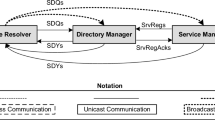Abstract
In service discovery protocols for MANETs, a key problem is to reduce the energy consumption and keep the system operating despite the occurrence of faults. In this paper, we propose a location-aware service discovery protocol that consists of a service selection, a service discovery and service invocation mechanisms. A service selection mechanism applies a data aggregation scheme in intermediate nodes to reduce the message replies in these networks. A service discovery mechanism adjusts the search area for each specific request and considers the requesting node’s location, the request response time and the maximum node speed to provide fault tolerance in order to deliver packets in adversarial environments. A service invocation mechanism sets up how the services could be accessed and used. Results show that these mechanisms make it possible to maintain the trade off between the discovery success rate and the message reply reduction, hence minimizing the network traffic.















Similar content being viewed by others
References
Arnold K (1999) The Jini specification, ser. Jini technology series. Addison Wesley
Balaji R, Jarmo H, Bilhanan S (2008) “Service discovery framework for manets using cross-layered design,”. In: Proc. 6th international conference on Wired/wireless internet communications (WWIC’08). Tampere, Finland, pp 152–163
Chakraborty D, Joshi A, Yesha Y, Finin T (2006) “Toward Distributed Service Discovery in Pervasive Computing Environments,” IEEE Trans Mob Comput, pp. 97–112
Chowdhury C, Neogy S (2012) “Reliability of mobile agent system in qos mobile network,” in COMSNETS, pp. 1–2.
Clausen T, Jacquet P (2003) “Rfc3626: Optimized link state routing protocol (olsr),” RFC Editor United States
Gadallah Y, Serhani MA (2011) “A wsn-driven service discovery technique for disaster recovery using mobile ad hoc networks,” in Wirel Days, pp. 1–5.
Gomes ATA, Ziviani A, dos L, Lima S, Endler M, Chelius G (2008) “Mitigating reply implosions in query-based service discovery protocols for mobile wireless ad hoc networks,” in The 11th International Conference on Ad Hoc Netw Wirel (ADHOC-NOW), vol. 5198. Springer pp. 29–42
Guttman E (1999) Service location protocol: automatic discovery of ip network services. IEEE Internet Comput 3(4):71–80
Helal S, Desai N, Verma V, Lee C (2003) “Konark - a service discovery and delivery protocol for ad-hoc networks,” in IEEE Wirel Commun Netw Conf (WCNC’03), pp. 2107–2113
Issariyakul, Hossain E( 2009) An Introduction to Network Simulator NS2. Springer [Online]. Available: http://books.google.com.br/books?id=cD69He_oU60C
Kniess J, Loques O, Albuquerque CVN (2009) Location aware discovery service and selection protocol in cooperative mobile wireless ad hoc networks. In: Proceedings of the 28th IEEE international conference on computer communications workshops (INFOCOM’09). IEEE Press, Piscataway, pp 367–368
Lenders V, May M, Plattner B (2005) Service discovery in mobile ad hoc networks: a field theoretic approach. Pervasive Mob Comput 1(3):343–370
Marin-Perianu S (2008) “Wireless sensor networks in motion: clustering algorithms for service discovery and provisioning,” Ph.D. dissertation, University of Twente, Enschede, [Online]. Available: http://doc.utwente.nl/60028
Marin-Perianu R, Hartel P, Scholten H (2005) A Classification of Service Discovery Protocols. Centre for Telematics and Information Technology, University of Twente
Mian AN, Baldoni R, Beraldi R (2009) A survey of service discovery protocols in multihop mobile ad hoc networks. IEEE Pervasive Comput 8(1):66–74
Miller B, Bisdikian C (2001) Bluetooth revealed. Prentice Hall PTR
Nidd M (2001) Service discovery in deapspace. IEEE Pers Commun 8(4):39–45
Salutation (1999) “Salutation architecture specification,” [Online]. Available: ftp://ftp.salutation.org/salutesa20e1a21.ps
Serhani M A, Gadallah Y (2010) “A service discovery protocol for emergency response operations using mobile ad hoc networks,” in Telecommunications (AICT), 2010 Sixth Advanced International Conference on, pp. 280–285
van der Aalst WMP (2010) Process discovery: capturing the invisible. IEEE Comp Int Mag 5(1):28–41
Varshavsky A,Reid B,de Lara E (2005) “A cross-layer approach to service discovery and selection in manets,” in The 2nd IEEE Int Confon Mob Adhoc Sens. Syst Conf, pp. 459–466.
Waal C, Gerharz M (2003) “Bonnmotion: a mobility scenario generation and analysis tool,”. In: Communication systems group, institute of computer science IV. University of Bonn, Germany
Acknowledgements
This work was primarily supported by Santa Catarina State University (UDESC) and in part by CNPq, CAPES, FAPERJ, TBE/ANEEL and CELESC and ANEEL.
Author information
Authors and Affiliations
Corresponding author
Additional information
Communicated by: H. A. Babaie
Rights and permissions
About this article
Cite this article
Kniess, J., Loques, O. & Albuquerque, C.V.N. Service discovery with time constraints in mobile ad hoc networks. Earth Sci Inform 8, 439–452 (2015). https://doi.org/10.1007/s12145-014-0164-4
Received:
Accepted:
Published:
Issue Date:
DOI: https://doi.org/10.1007/s12145-014-0164-4




